Ah, Rankin-bass, the studio responsible for, depending on who you ask, beloved stop-motion holiday films or nightmare fueled abominations. Whether you love ‘em or hate ‘em, you can’t deny the cultural impact they’ve had. It’s an impact that stretches far beyond just Rudolph and Frosty.
So I’ve decided to figure out which of these films is the best. To maintain my own sanity, and so that I don’t have to watch the entire original run of the “ThunderCats,” I’ll be sticking to the stop-motion films, alongside the ones that fit the holiday season.
Note: The list is incomplete because I wasn’t able to get a hold of a copy of “The Stingiest Man In Town.”
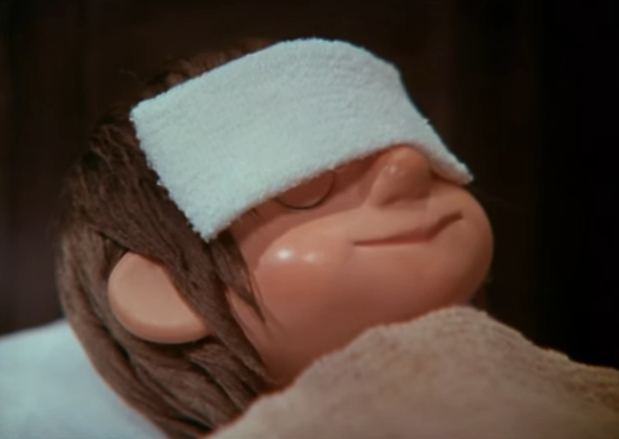
1. “The First Christmas”
Lucas, a poor shepherd boy has been blinded after nearly being struck by lightning. He’s taken into a nearby abbey where a local nun, Sister Teresa takes care of him. The father of the abbey insists that it’s no place for a child and that as soon as Christmas is over Lucas will have to go to an orphanage.
For most of their specials Rankin does a pretty good job of walking the line of acknowledging the religious nature of Christmas without launching into a full on sermon. Here I wish they had stepped over that line, because without it, this movie is just straight up boring. At first it seems like that’s where the story is headed – it takes place in an abbey, a blind shepherd, etc. But the film never capitalizes on those themes, there’s a nativity scene at the end that explains the origins, but it’s not really set up. It just happens.
And that’s a majority of the film, things just happen and it’s all incredibly boring.
Stray Observation: Sister Teresa explains snow the same way Anakin Skywalker explains sand.
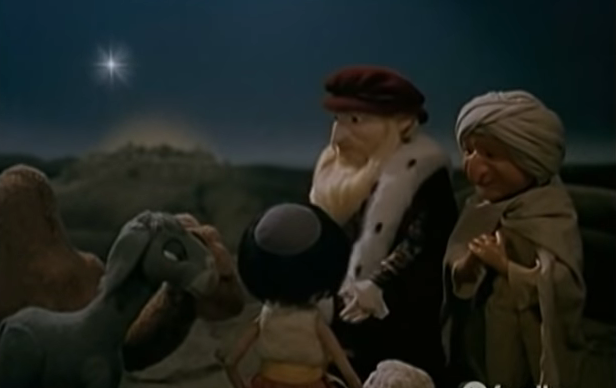
2. “The Little Drummer Boy: Book 2”
Picking up right where the last movie left off, Aaron travels with one of the wise men, Melchior, to visit a friend of his at the edge of town. That man, a bell maker, has spent years making a special set of silver bells in preparation for the baby Jesus’ birth, only for them to be taken by the Romans during tax collection. Now with the aid of Aaron and Melchior, the three plan to get the bells back.
Why? It’s the question I kept asking as I was watching it.
The sequel adds absolutely nothing to the original special and does absolutely nothing to justify its existence. It’s filled with padding and is the worst animation I’ve seen in a Rankin-Bass production. The only things that saves it are the song “Money, Money, Money” and the fact that this feels less like a stand-alone idea, but more like a backdoor pilot that never took off.
If that was the case I would have probably watched it when I was younger, but standing side by side with the original “Little Drummer Boy” it’s pretty miserable.
Stray Observations: Why doesn’t Melchior just buy back the bells, he’s a king.
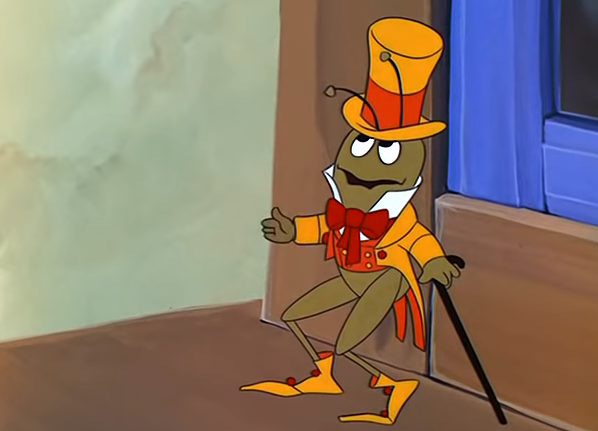
3. “Cricket On the Hearth”
Cricket Crocket has found himself a nice home living with a toy maker, his daughter and her fiancé. Tragedy strikes as the daughter is struck blind when her fiancé is lost at sea. The toy maker is willing to do anything to care for his daughter.
This movie is boring, and it is ugly. I could handle one, I cannot handle both. Some of the character designs look like they belong to different movies entirely. Some of the background characters have simple black button eyes, while others have full pupils.
The Toymaker especially looks like he doesn’t belong. His colors and design is very minimalist, and next to his slightly more detailed daughter, it’s jarring. There’s also a Goofy-Pluto situation where the main villain has a pet crow that no one but other animals understands, but other animals are shown to be intelligent and wear clothes.
Stray Observations: This movie has two narrators: the cricket and a live action one – to let you know this movie really was based on a story by Charles Dickens.
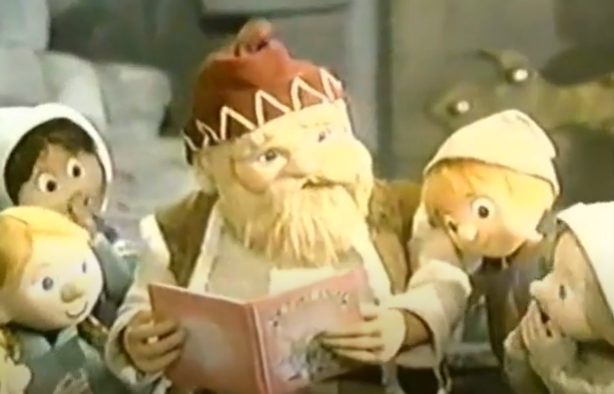
4. “The Life and Adventures of Santa Claus”
Deep in the mystical valley of the immortals, a council is being held to decide the fate of Santa Claus. A mortal being raised in the valley, he will die that very night unless the council decides to grant him immortality.
Jumping to the very end of the line “The Life and Adventures of Santa Claus” was the last stop-motion film made by Rankin-Bass. The signs of a studio struggling financially are all over this film. A lot of voice talent and writers were borrowed from “ThunderCats” for the film.
At the same time, eagle eyed watchers will notice a number of reused character models from older films, paired alongside a batch of newer, more unsettling models.
And as for the question of whether Santa deserves immortality, the answer is no. At least not this version of him.
This Santa doesn’t really do anything. He delivers toys, but that’s mostly off-screen. Every problem that arises in the movie is solved by the immortals. They deal with the villains, they Santa when he’s attacked by them, they even give him his sleigh and reindeer.
The best parts of the movie are the parts that remind you this was made by the same people that made “ThunderCats.” Even then it feels out of place.
Stray Observations: I wasn’t expecting to see a Pixie melt a dragon when I started watching these films, but here we are.
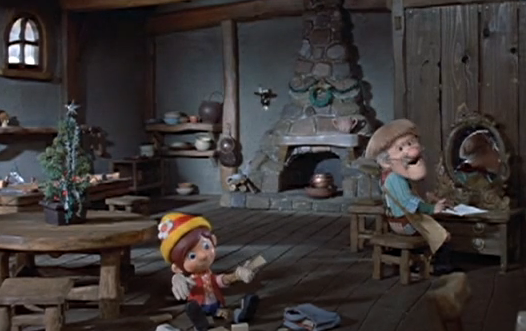
5. “Pinocchio’s Christmas”
Brought to life through magic, Pinocchio the living puppet learns the difference between right and wrong as he experiences his first Christmas and tries to find a present for his father Geppetto.
When I first started this movie, I had to stop it and make sure I wasn’t watching a sequel to some other Rankin-Bass film.
The company did get its start making short Pinocchio animations. But no, this is its own original movie that eventually gets around to telling the origin of Pinocchio, but I wouldn’t blame anyone for making the same mistake.
The movie starts off assuming you know these characters, probably from the Disney version. It then tries to tell you it’s own version of the story, which isn’t as good. Unlike most versions of the story when Pinocchio’s misdeeds come from general ignorance and naivety, this version makes clear that Pinocchio was a jerk from day one. There’s also no real reason to put the movie at Christmas time either – doing so only makes Pinocchio and his bratty attitude stand out even more.
Stray Observations: This is the only one of these specials without a narrator.
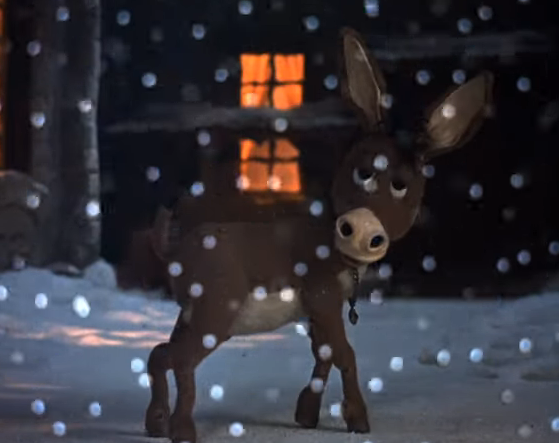
6. Nester the Long-Eared Christmas Donkey
Born in the northern reaches of the Roman empire, Nester the donkey has unusually long ears that get in the way when he tries to help and everyone he meets can’t help but laugh at them. Kicked out of his home and left on his own, Nester is visited by a cherub who tells him that his ears are destined for something great.
Nester is essentially a more religious telling of Rudolph. The major difference is that Nester is exceptionally mean spirited. Where Rudolph meets people that accept him and his nose on his journey, only the cherub sent from heaven doesn’t laugh at Nester at first sight. Where Rudolph is either laughed at or given the cold shoulder by his bullies, Nester is physically man-handled on more than one occasion.
The music in the special doesn’t help, the chorus of the song devotes time to talk about how mean everyone is and how broken-hearted Nester is. It doesn’t help that the ending of the movie doesn’t make any sense, Nester returns home and gets a hero’s welcome, but there’s no reason any of those characters would know what Nester did.
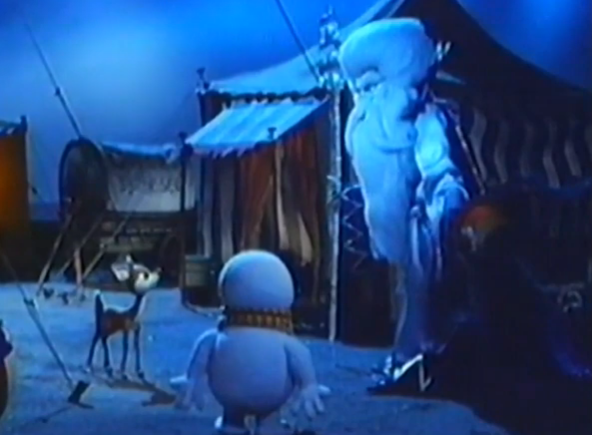
7. “Rudolph and Frosty’s Christmas in July.”
The long-forgotten wizard king of the north pole has reawakened. Determined to regain control of his icy domain from Santa Claus, he hatches a scheme to get rid of him and Rudolph – whose nose is the only thing standing in his way.
Why was Frosty in this movie? It’s a question that didn’t occur to me until 2/3 of the way through and apparently it didn’t occur to the writers either, because they don’t give Frosty a reason to be in the movie until 2/3 of the way through.
At an hour and a half long, this is the longest of the Rankin-Bass specials and the villain’s plan is increasingly convoluted to match it. The whole plan hinges on tricking Rudolph into accidentally committing a crime which will snuff out his nose. At any point though the villain could have just as easily blackmailed Rudolph into committing a crime.
The film takes and pieces together different elements from the different Rankin-Bass specials but making all these films canonical makes things more confusing. For instance, a big deal is made in the movie about Frosty melting and the villain getting a hold of Frosty’s hat. But the previous Frosty films established that Frosty doesn’t really need his hat and it doesn’t really matter if Frosty melts as long as you refreeze him.
The songs are either rehashed or forgettable and the whole movie is a case of we did it because we could, not because we should.
Stray Observations: A Rudolph movie should not have me debating ethics and intent to commit crime.
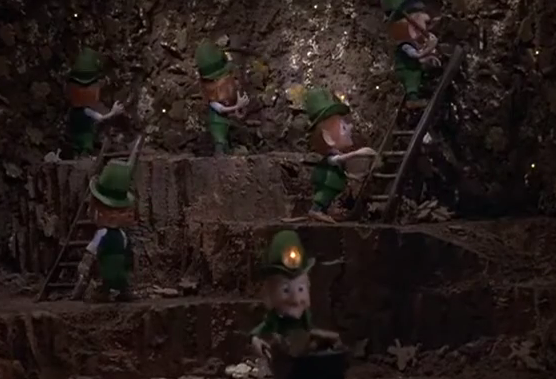
8. “The Leprechaun’s Christmas Gold.”
On his way home to Ireland, cabin boy Dinty Doyle finds himself stranded on an island after being sent ashore to grab a Christmas tree. Digging up the tree, Dinty accidentally unleashes an ancient banshee who wants the gold of the nearby leprechaun’s living on the island.
Watch enough of these films and you’ll notice that Rankin-Bass liked to shove Christmas into as many other holiday’s as it possibly could. So while at first glance their attempt to blend Christmas with St. Patrick’s day seems egregious – it actually works really well.
The story is well paced for a half and hour special, quickly explaining why the Leprechauns are stranded on the island and why the banshee wants their gold.
While the Irish paint job can feel overdone at times (the Leprechaun’s name is Blarney Kilarney) it’s also nice to see one of these specials actually dive into a different culture. Most of the others take place somewhere in the U.S or somewhere in Europe. Having to marathon these, seeing something so drastically different, not only in tone, but also color palette really helps shake things up. Those Irish shanties are just too catchy.
Stray Observations: If Rankin-Bass had kept going, I’m pretty sure they would have provided Nightmare before Christmas decades before Tim Burton.

9. “Frosty’s Winter Wonderland.”
Fulfilling his promise to be back again someday, Frosty returns from the North Pole now that it’s started to snow.
Realizing it won’t last and that he’ll be lonely when he goes back, Frosty and the kids decide to make Frosty a wife. Meanwhile a jealous Jack Frost is determined to steal Frosty’s hat.
In many respects “Frosty’s Winter Wonderland” is as good as the original. Where it falters though is that it makes me ask too many questions. All these films have their faults with story, animation, etc. But they manage to bring up enough Christmas cheer and charm to overlook them.
Winter Wonderland struggles with that, when it keeps bringing more snowmen to life. Frosty’s wife Crystal is brought to life by giving her flowers. They bring a Parson to life to marry them by giving him a bible. And near the end Jack Frost blows Frosty’s hat off only for him to be immediately reawakened by Crystal.
You’re not really supposed to question magic too deeply in stories, but the more snowmen that hop to life just by giving them something fitting leaves me too deep in thought for my liking.
Stray Observations: Frosty just pulled a Pygmalion. Also, whatever happened to the Parson?
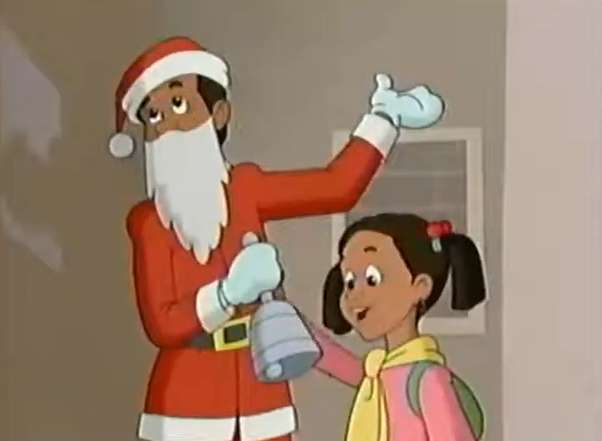
10. “Santa, Baby.”
Granted one wish after saving the Partridge in A Pear Tree from freezing, a little girl wishes for her struggling father to have a hit song. The bird obliges by placing the father in a Santa costume to teach him about life.
Over a decade after their last film, Rankin-Bass produced their final film. In some ways it sticks to the formula; an omniscient narrator tells a musical story about the time something magical happened at Christmas time.
Stylistically, this looks nothing like any of the other of Rankin-Bass specials and that is a relief. The music esques classical tones for updated R&B and Hip Hop remixes and with singers like Patti LaBelle and Eartha Kitt lending their voices, they tend to hit more than miss.
The movie tries for a more down to earth story – the father really is just in a Santa Suit and there’s no magical component to it. In fact, everyone from his daughter to his wife recognizes him. The partridge wants him to focus more on life and the people around him, but we don’t really get to spend a lot of time with the community, their interactions mostly covered in a montage. Instead, some of the focus is taken up by one of the only side plots in this entire filmography.
Stray Observations: Rankin has always let child actors do voices, but usually for side or background characters. Here they let one voice the daughter, and she tries, but it’s rough.
Joshua Fadare
Reporter


